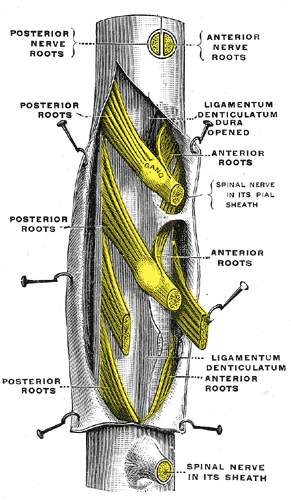|
Denticulate ligaments
Denticulate ligaments (also known as dentate ligaments) are lateral projections of the spinal pia mater[1] forming triangular-shaped ligaments that anchor the spinal cord along its length to the dura mater on each side.[2] There are usually 21 denticulate ligaments on each side, with the uppermost pair occurring just below the foramen magnum, and the lowest pair occurring between spinal nerve roots of T12 and L1.[1] The denticulate ligaments are traditionally believed to provide stability for the spinal cord against motion within the vertebral column.[citation needed] Their tooth-like appearance originates the word which derives from Latin denticulatus, from denticulus (meaning ‘small tooth’).[3] AnatomyThe bases of denticulate ligaments arise in the pia mater and are firmly attached to the arachnoid mater and dura mater at the apex.[2] The denticulate ligaments extend across the subarachnoid space between anterior nerve roots and posterior nerve roots, piercing the intervening spinal arachnoid mater to reach the dura.[1] StructureEach denticulate ligament is composed of a single narrow fibrous strip that extends from the craniovertebral junction to T12. Each ligament features 18-20 triangular extensions that attach to the dura at their apices[citation needed] in between successive nerve roots.[1] The triangular extensions are smaller and more numerous at the cervical levels, and are larger and less numerous at the thoracic levels. The apices of the extensions attach to the dura via fibrous bands at cervical levels (each band 3–5 mm (0.12–0.20 in) long) and lower thoracic levels (21–26 mm (0.83–1.02 in) long), whereas they attach directly to the dura at upper thoracic levels.[citation needed] These ligaments may be affected by altered motion and position of the vertebral segments.[citation needed] Microanatomy/histologyThe narrow fibrous strip of the denticulate ligament features longitudinally oriented collagen fibers, whereas the triangular extensions are composed of transverse and obliquely oriented collagen fibers. The collagen fibers are thicker and more abundant at the cervical than at the thoracic levels.[citation needed] BiomechanicsDenticulate ligaments are characterised by high extensibility (on average 50% of their initial length) and relatively low force necessary to rupture them (around 1 N). Their strength, especially in cervical region, decreases in caudal orientation.[4] Clinical significanceFrom a clinical standpoint, denticulate ligaments do not play a significant role in lumbar spinal stenosis when compared to issues such as disc herniations, facet hypertrophy, shape of spinal canal, size of spinal canal, ligamentum flavum hypertrophy, or degenerative joint disease resulting in bony osteophyte formation.[citation needed] Additional imagesSources
See alsoReferences
External links
|
||||||||||||||||||||||


